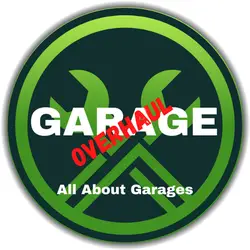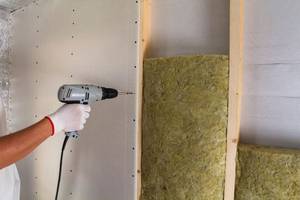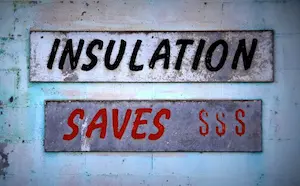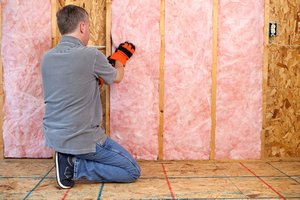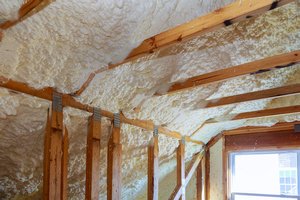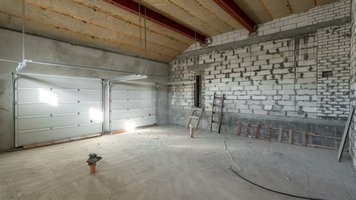Garage Insulation Types And Materials: Ultimate Guide
This post contains affiliate links.
If you intend to make your garage usable all year round, you will need to insulate it. Insulation prevents the garage from becoming a burning oven in the summer and freezer in the winter.
However, garage insulation can be a minefield and maze to many. There are so many types and materials involved. What are the garage insulation types and materials?
Insulation types are the form of the insulation and how you can apply them. Insulation materials are the material used to make the insulation. Examples of insulation types include batts and rolls. Examples of insulation materials include fiberglass, cellulose, or foam.
In this guide, we explore the different garage insulation types and layers. We also look at their strengths and weaknesses, and which one may suit you needs better.
What Are The Types Of Garage Insulation?
There are many types of garage insulation. Each comes with its own set of strengths and weaknesses. These include:
- Batts
- Rolls
- Loose Fill
- Sprayed-On
- Rigid Foam
- Reflective
| Type | Pros | Cons | R-Value |
| Batts | -Easy to handle. -DIY friendly. -Good for unfinished surface. | -May not work with large spaces. -Gaps may cause weaker performance. | 2.9 – 4.3 |
| Rolls | -Customized cutting. -DIY friendly. -Good for long, continuous surface. | -Harder to handle. | 2.9 – 4.3 |
| Loose Fill | -Good to use on hard to reach areas such as ceiling. -No cutting required. | -Needs equipment to spray the insulation material. | 2.2 – 3.8 |
| Sprayed-On | -Good to use on hard to reach areas such as ceiling. -No cutting required. -Can be resurfaced and refinished after application. | -Needs equipment to spray the insulation material. -May be more expensive. | 3.7 – 6.2 |
| Rigid Foam | -Excellent performance. -DIY friendly. -Easy to handle. | -Expensive. -Not very flexible. -Less environmentally friendly. | 4 – 6.5 |
| Reflective | -Reflects heat. -Complements other insulation types. -DIY friendly. | -Does not work much in winter. | – |
Batts
You best imagine insulation batts as floor tiles. However, you get thick, fluffy batts cuts instead of thin ceramic tiles. You then stick them to the wall, ceiling, floor, or anywhere you desire.
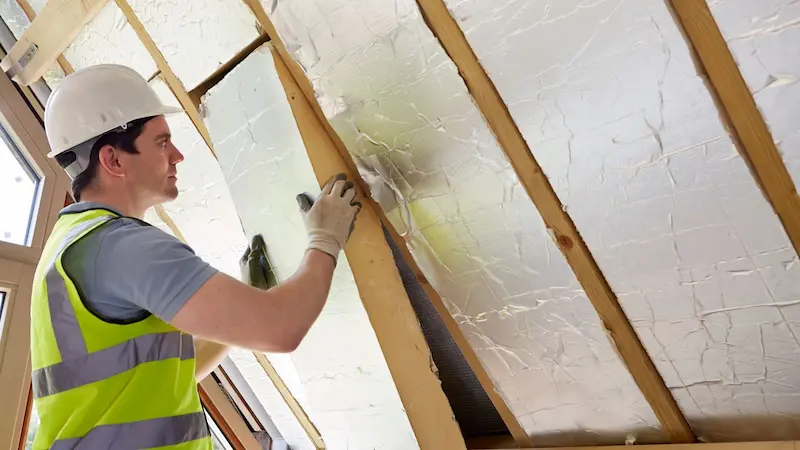
Insulation batts are also one of the most affordable ways to insulate your garage. Prices may depend on the materials used on your batts. Popular batts are made from fiberglass, mineral wool, or natural fibers. Some also have reflective surfaces for better heat deflection.
It is designed for easy handling since it is in small pieces. Common insulation batts come in 2×4 feet pieces, with other sizes available. You can also easily stick them between framings, such as studs and joists.
You can cut them into custom shapes to fit into odd gaps if required. Some insulation batts also come with stick-on adhesive, making installation easy. This makes insulation batts very DIY friendly.
Despite its upside, insulation batts do not perform the best. Regular batts made from fiberglass may have an R rating of 2.9 – 3.8. High-density bats may have an R-value as high as 4.3 per inch.
Rolls
Insulation rolls are similar to insulation batts in many ways. The only major difference is that insulation rolls do not come pre-cut. Instead, they come in huge rolls ranging from 20 to 40 feet.
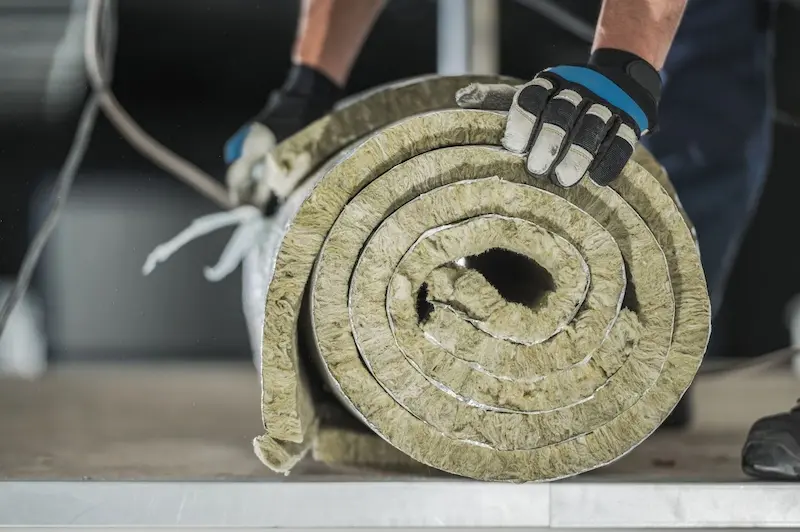
This means insulation rolls will be more difficult to load, transport and move around. You also need to unroll and cut the insulation before installing them.
However, this gives you a long, continuous piece of insulation. You can fit one single piece of insulation on long walls or ceilings. This reduces gaps between insulation pieces, a common problem with batts.
On effectiveness, rolls perform similarly to batts. Both rolls and batts are about the same in price too. This makes them both affordable options for you to insulate your garage.
Loose Fill
Unlike batts or roll insulation, loose fill has no shape. It comes to you in bags and looks like the stuffing from inside a soft toy. Loose-fill insulation is usually made of fiberglass, cellulose, or mineral wool.
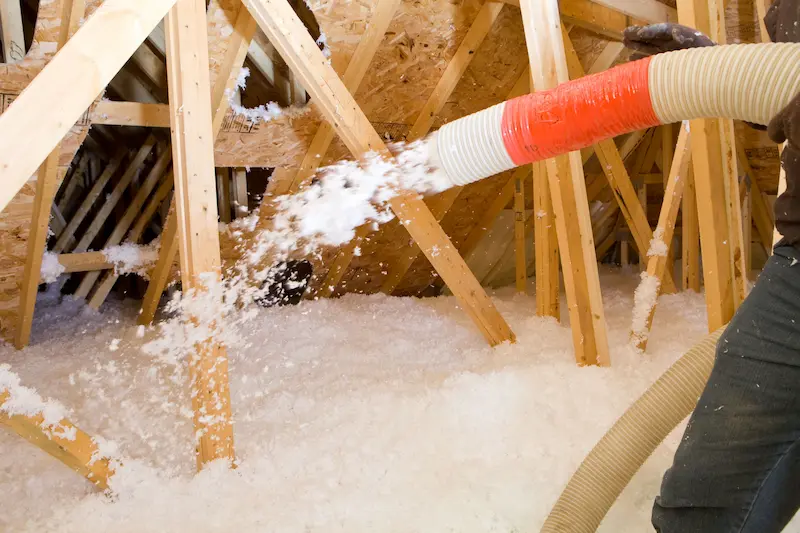
You usually blow or spray them into place with special equipment. This makes loose-fill insulation excellent for filling various forms or spaces. This makes loose-fill insulation perfect for angled or odd-shaped surfaces.
Price-wise, they are more expensive than batts or rolls. However, there are more expensive insulations you can install than loose fill. The R-value of loose-fill insulation ranges between 2.2 to 3.8, depending on the material used.
Sprayed-On
One of the easiest ways to apply insulation is to spray them on. These sprayed-on insulation are basically liquid latex or polyurethane foam.
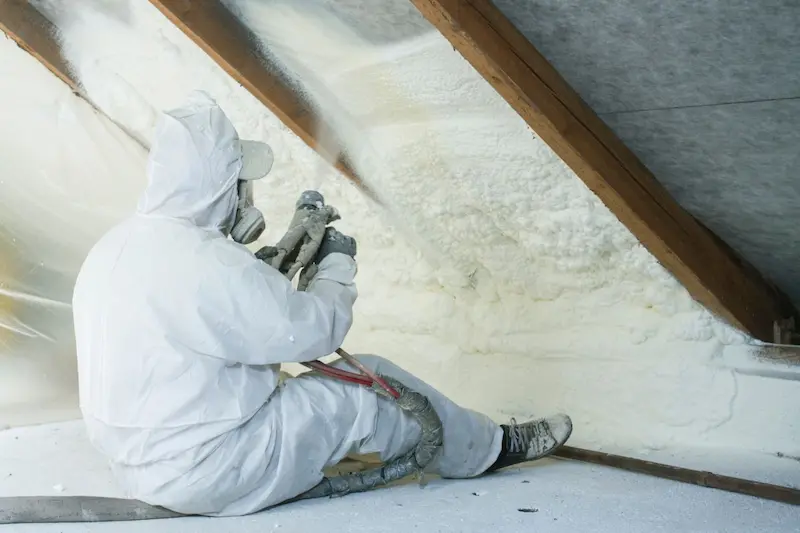
It is sprayed over and throughout areas by shooting the insulation at the wall with a hose. As it dries, it expands and then fills the space. As a result, they are excellent options for insulating odd or hard-to-reach areas. These include ceilings, doors, windows, or vents.
Once the insulation has hardened, it forms a solid, dense foamy surface. You can refinish it in many ways. It is common to see people trim the surface flat and then paint and stain them.
Sprayed-on insulation has two types, open-cell, and closed-cell. Close-cell type is denser and performs better, with a higher R-value of 6.2. It is also more expensive. Open-cell insulation has an R-value of 3.7.
Rigid Foam
Rigid foam insulation may be the best-performing insulation of the bunch. It is rigid, hard boards, usually made from polystyrene, polyisocyanurate, or polyurethane.
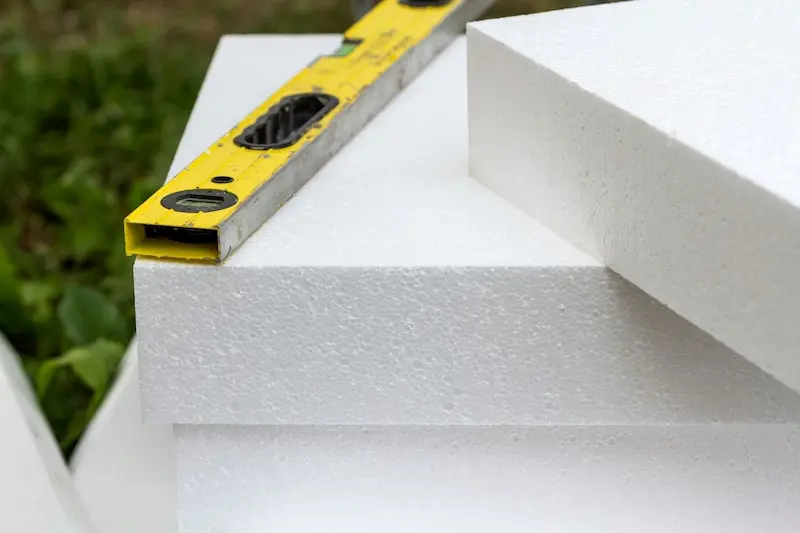
They are commonly used during the construction of the house. They are best used for flat surfaces like floors, foundations, or basement walls. Rigid foam insulations are also used in wall sheathing and low-sloped ceilings.
It performs excellently, with an R-value of 4 – 6.5, depending on thickness. It is excellent for cold climates and DIY friendly too.
The issue with rigid insulation is the price. It is probably the most pricey option on the list. Rigid insulation is also less eco-friendly, especially if you choose polystyrene.
Reflective
Reflective or radiant insulations do not exist on their own. Instead, it complements other types of insulation types. For example, you may see batts or rigid foam pads with reflective aluminum surfaces on one end.
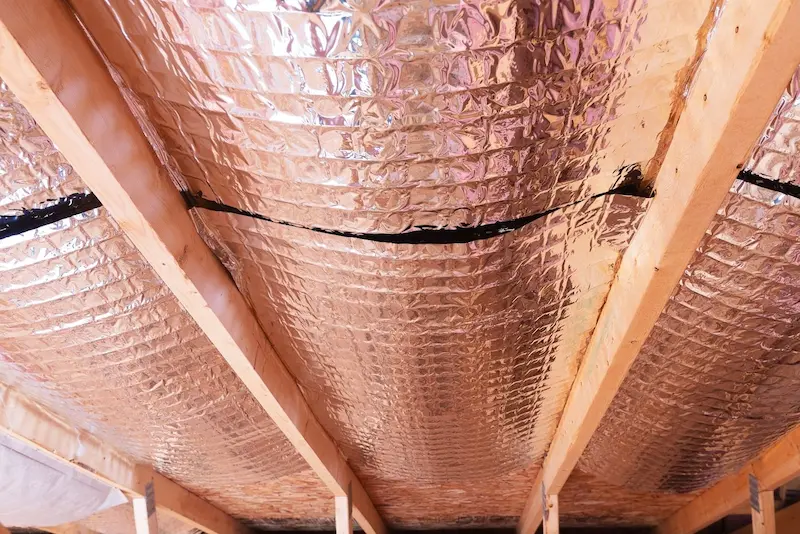
This is because the main function of reflective insulation is to deflect heat and prevent them from entering your garage. This means reflective insulation is a godsend during hot summer months. However, they may not do much during winter.
What Are The Types Of Garage Insulation Materials?
There are many types of garage insulation materials, traditional or modern. The most popular ones include:
- Fiber
- Cellulose
- Mineral wool
- Spray foam
- Rigid foam
- Polystyrene
- Aero foam
- ThermaCork
| Materials | Pros | Cons |
| Fiberglass | -Affordable. -Less dusty compared to cellulose. | -Skin and lung irritant. |
| Cellulose | -Good sound insulation. -Recycled product. | -Harder to install. -Dusty. |
| Rigid Foam | -Very good performance. | -Rigid. -May not be fire resistant. |
| Spray Foam | -Good for retrofit projects. -Surface can be refinished easily. | -Expensive. -May be overkill for most projects. |
| Mineral Wool | -Naturally fire resistant. -Less irritating on skin than fiberglass. | -Lung irritant. |
| Soy Fibers | -Good performance. -Good value for money. | -Not popular. -Harder to source. |
| Natural Wool | -Good moisture absorption. -Good for health. | -May not last long. -Low fire-resistance. |
| Hemp | -Biodegradable. -Does not attract insects or rodents. | -Not popular. -Harder to source. |
| Recycled Denim | -Good sound insulation. -Recycled product. | -Slightly more expensive. |
| Aerogel | -Long lasting. -High performance. | -Expensive . |
| ThermaCork | -All natural. -Good sound insulation. | -Expensive. |
| Polystyrene | -Non-biodegradable . -Very good performance. | -Can be recycled. |
Fiberglass
Fiberglass is the most popular insulation materialin garages. This is because it works well and is cheap. Fiberglass insulation is usually sold as batts, rolls, and loose fills.
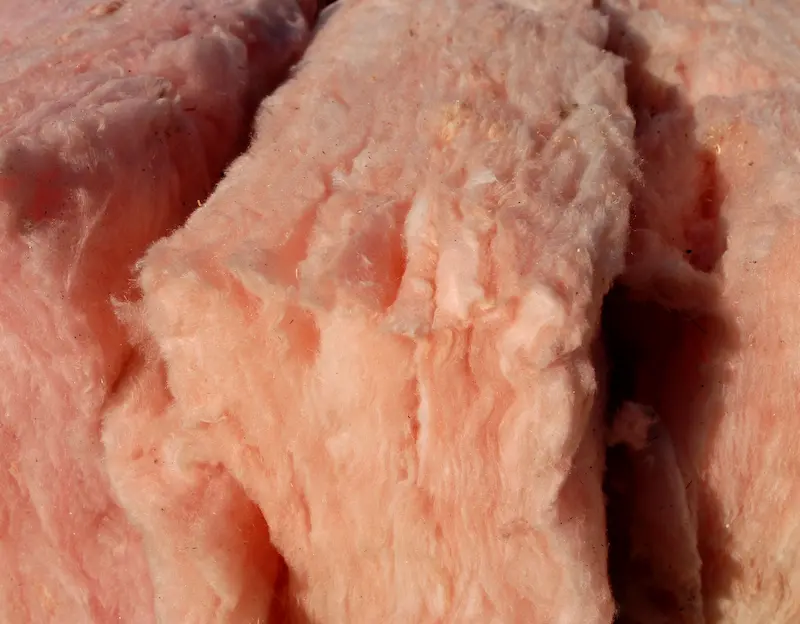
Suppose you plan to install insulation on your wall and leave the surface uncovered. This means leaving the wall exposed and not covered with drywall or plywood.
In that case, use fiberglass batts that are wrapped in a plastic film. These will give the walls a more finished look.
You also won’t have the itchy fibers of the insulation exposed and ready to catch dust at all times.
Fiberglass is a skin and lung irritant. You should always wear protective eyewear, gloves, masks, and clothing. Cover yourself up when working with fiberglass insulation.
Cellulose
Cellulose is a loose-fill insulation, sold in bags. It is usually made from recycled paper products. It is also common to see manufacturers add borate for fire and insect resistance.
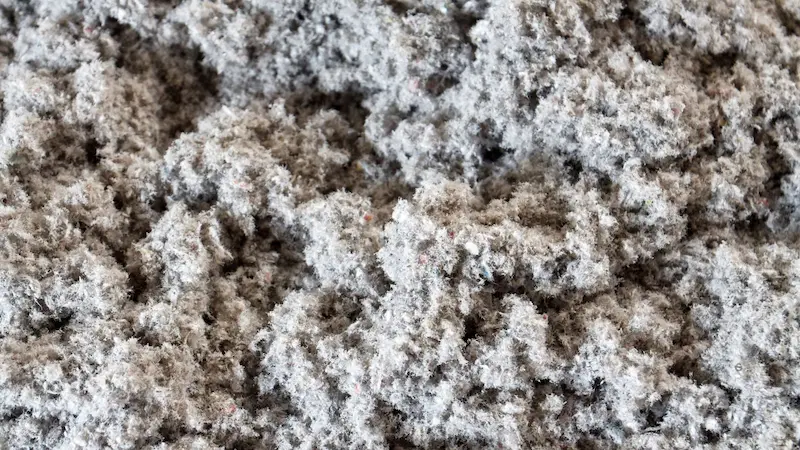
Cellulose is a good sound insulation material too. You can use it to keep your garage sounds from traveling out. It has an R-value of about 3.8
Cellulose is usually sprayed into wall and ceiling cavities with the blowing machine. The machine aerates the cellulose and fluffs it up. Blowers can be rented. Some home centers will loan you a blowing machine if you buy cellulose.
Cellulose is suitable only for finished garage walls and ceilings. This is because it is only in loose-fill form.
If the garage is already finished (but uninsulated), you can install cellulose too. Cut a hole in the wall, and spray the insulating into the cavities between frames. Then seal up the holes.
Rigid Foam
Rigid foam usually comes in 4 x 8-foot sheets and thicknesses of 1/2 inch to 4 inches. Foam insulation are commonly made with polystyrene, polyisocyanurate, or polyurethane.
Rigid foam offers a high R-value, which means it insulates very well. It can also be cut to fit in almost any shapes. As a result, rigid foam insulations are a good choice for thin walls and garage doors.
However, not all are fire-resistant, so check before you purchase. Non-fire-resistant foams should not be used if you intend to leave them exposed.
Suppose you’re turning the garage into a living or workspace and want to insulate the floor. In that case, consider using rigid foam, and then you cover them in plywood or other subfloor material.
Spray Foam
Spray foam is excellent for both R-value and air-sealing. It is a premium material typically used for energy-efficient construction. As a result, spray foam is overkill for most garage projects.
However, spray form may make sense if you convert the garage into a living space. Spray the insulation on, trim and refine the surface, and then paint them over to make them homey.
Spray foam is popular with retrofitting projects, such as:
- Attic conversions.
- Basement remodels.
- Crawl space upgrades.
- Remodeling projects when walls are exposed.
Mineral Wool
Mineral wool is man-made insulation, usually taking natural minerals. Popular ones include slag and rocks. The most common mineral wools are rock wool or slag wool.
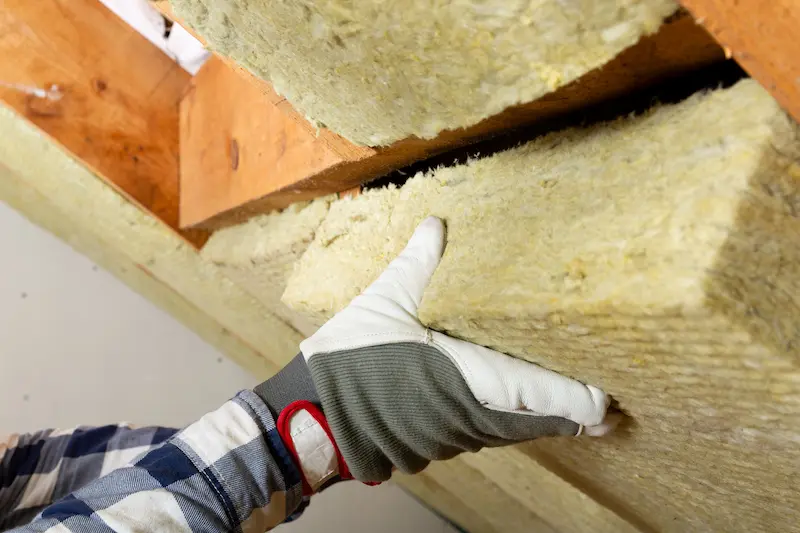
Both mineral wool insulations are naturally fire-resistant. They come as batts, rolls, and loose-fill and are easily sourced from your local home parts store.
Mineral wool is generally slightly more expensive than fiberglass. However, they generally perform slightly better. When working with mineral wool, ensure to wear breathing masks. Fine mineral wool is a known lung irritant.
Soy Fibers
Soy fibers are an up-and-coming insulation material. Despite having only a small market share, soy-based foams are growing in popularity.
This is because soy fibers are dense. This means they are good at insulating heat, cold, sound, and air. No more drafty garage.
Soy fibers are also Class 1 fire-resistant. It also releases no off-gas or other compounds that can be health risks. The soy fibers are also completely biodegradable and can be easily recycled.
Natural Wool
Probably the earliest form of insulation. Natural wool remains a popular option to insulate garages. They are quite affordable and are easy to source.
Natural wool is appreciated for its ability to absorb moisture and then release it later. It is also a great sound insulator, especially when packed densely. They can also improve air quality, as it absorbs air pollutants well.
Natural wool is also all-natural. This means you are not breathing in chemicals or carcinogens. Wool is also a natural fire retardant.
Hemp
Hemp is not a popular insulation material in the US, but it is gaining popularity. Hemp insulation is particularly popular with those that want to use eco-friendly materials.
Hemp insulation is biodegradable and fully recyclable. It also contains no hazardous materials since it is all-natural. It also can absorb a large amount of moisture.
Best of all, hemp insulation is a natural pest repellent. You would not have to deal with insects or rodents.
Recycled Denim
Recycled denim insulation pieces are made from recycled denim clothing, and denim cotton. Denim itself is natural, so it is non-toxic and non-irritating.
Denim is typically more expensive than fiberglass or other insulation materials. However, it is easy to install. Recycled denim is also environmentally friendly.
It also does not contain harmful components like volatile organic compounds and formaldehyde. The manufacturing process also does not generally produce waste. This means all used denim can be packed inside the insulation.
Recycled denim insulation is also a good sound insulation material. You can run your saws or play music in your garage at night without waking your neighbors.
Aerogel
Eco-friendly materials do not always have to mean all-natural. Aerogel is one of the examples. In 1931, Samuel Stephens Kistler invented the Aerogel. This is a material composed of more than 90 percent air.
It’s made by removing the liquid from silica under high pressure and temperature. Since it is basically trapped air, it is an excellent insulation material. It is also natural and does not emit any harmful off-gas or compounds.
You can buy Aerogel in sheets or stickers that make it easy to apply. The ultra-lightweight material can cost up to $2 a foot but will save you money on heating and cooling costs.
ThermaCork
ThermaCork is made from oak trees’ outer bark. It is also a natural, renewable, recyclable, and biodegradable material. On top of that, ThermaCork actually has a negative carbon footprint.
ThermaCork provides excellent insulation and is capable of reducing energy consumption. It also retains its thermal capability far longer than most insulation choices. It’s also hypoallergenic, free of domestic toxins, and works to mute sounds.
If you consider yourself an eco-warrior, ThermaCork may be your best choice.
Polystyrene
Polystyrene may be the best-performing insulation material you can get today. It is actually a type of plastic. Some types of polystyrene may not be biodegradable, but most are recyclable.
Although plastic is not traditionally green, it’s considered to be in this instance. This is because the R-values are so high that it saves energy.
You can get polystyrene insulation in both foam boards or spray foam. The earlier is more popular since it adds structural integrity to walls.
